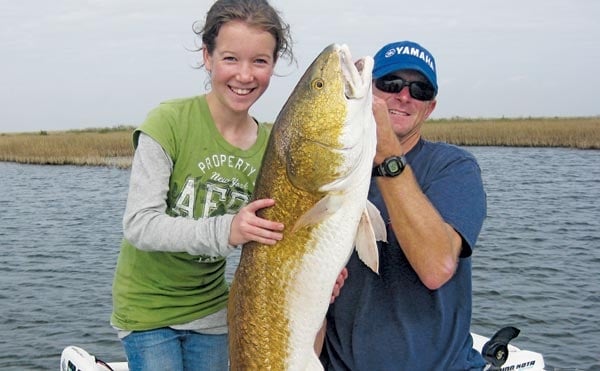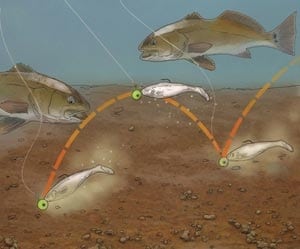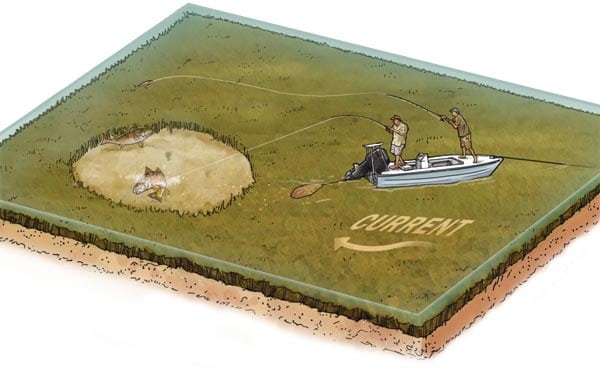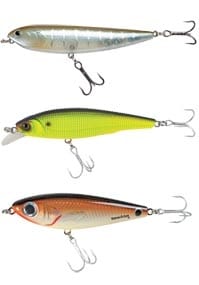
In a perfect world, all redfish (red drum) would be ravenous fools hellbent to strike any lure or bait tossed their way. But fishing pressure, clear water, shallow water and adverse weather conditions can make locating and triggering strikes from redfish as difficult as anything in fishing. Here’s how top anglers and guides turn tough conditions into consistent strikes from big, finicky red drum.
Fishing for Redfish During Cold Fronts
Fairhope, Alabama, guide Kevin Olmstead says redfishing during cold fronts can be challenging for anglers used to catching aggressive red drum in ideal conditions. When a drop in temperature or unstable weather put redfish off their feed, Olmstead recommends slowing lure retrieves and paying close attention to tackle details.
He favors 1/16-ounce jig heads with 2- to 3-inch soft-plastic grubs for lethargic redfish. That’s the best style of jig head for redfish in this scenario. He likes to cast, allow the lure to hit bottom and then, with short, slow rod twitches, impart subtle action to create soft bottom “puffs” behind the lure. The trail of bottom puffs from his jig imitates a fleeing crab or shrimp and tempts reluctant reds.

His favorite artificial baits are Berkley Gulp! lures in 3-inch Shaky Shad configurations, pearl-silver or smelt colored. He likes the built-in scent that tempts reluctant redfish.
Consider this way to rig a soft plastic to a jig head for redfish: A Bass Assassin jig head with a spring-lock screw to accommodate the grub works well.
A small No. 2 short-shank hook is best for cold-water reds. Olmstead prefers subtle natural colors and a gray lead-head jig in clear water during cool fronts. In dark or choppy water, he likes a chartreuse jig head.
“Chartreuse is a trigger for redfish,” he says. “And I want that color up front, where the hook is, when reds are slow takers in cool water. This produces more hookups when conditions are tough.”
Use Live Bait to Catch Lethargic Redfish
Trolling covers water fast and is a good way to find redfish. Trolled natural baits are especially deadly when redfish are scattered and reluctant to strike. In many cases, a moving bait is most natural to redfish used to seeing food flee.
Mullet, menhaden, mud minnows, killifish, pilchards, pinfish and similar inshore species are all highly effective when trolled behind a boat, says Jacksonville, Florida, angler and guide Danny Patrick.
Live baits hooked through both lips (from the bottom up) or through both nostrils are standard for trolling. Some species are best barbed through the lips, and others through the nostrils or up through the lower jaw and out one nostril. Experience is the best teacher here.
For the most natural presentation, avoid weights and floats with this redfish technique. But adding a bit of split shot or a rubber-core sinker makes sense in water over eight or 10 feet deep. In shallow water or over grass, rocks or jetties, a float ahead of a trolled live bait keeps it out of obstructions.
Speed kills baits, so troll slowly. Small outboards and sea anchors help keep speeds low. Electric motors are especially nimble around docks, jetties, seawalls and grass edges, all places where bait trolling excels and redfish reside.

Fishing With Popping Corks for Redfish
The venerable popping cork has been around about as long as anglers and redfish. Cutting-edge anglers may view a popping cork as a trademark of an amateur, but Port O’Connor, Texas, guide Petra Schultz says slower presentations catch more redfish.
“Often when redfish refuse lures, it’s because they are fished way too fast,” says Schultz. “Popping corks are really effective in dark water or in deeper water, where reds are hard to see. Popping-cork fishing is easy and attracts a lot of reds because it perfectly simulates feeding fish, and that draws hungry predators. When they show near a gurgling popping cork, they see or scent the bait or soft-plastic lure and strike. It’s simple and very effective.”
Schultz prefers live shrimp or croakers fished below a rattling popping cork. A 3-inch D.O.A. soft-plastic shrimp in avocado or a 3-inch Berkley Gulp! shrimp are effective substitutes for live bait. Make a cast, then chug hard several times and pause for five to 10 seconds; chug more, pause, reel and cast to follow the Schultz prescription. Her terminal rigs are simple: 18 inches of 20-pound fluorocarbon leader below a float positioned above the barrel swivel connecting line to leader. For live bait and Gulp! lures, a Mustad 3/0 hook is standard, 5/0 when baits are extra large.
Fishing for Redfish in Shallow Water
Guide Greg Hildreth spends a lot of time chasing redfish in the Golden Isles of coastal Georgia, one of the best places in America to catch them.
“We like to sight-fish for reds in shallow water,” says the Brunswick-based guide. “We use light tackle, fish from a very small boat and pole it quietly into casting position when we see fish.” Hildreth believes silently poling to sighted reds is better than using an electric trolling motor. “We make very long casts to unspooked, happy redfish,” he explains. “Sometimes we have to be patient and wait for just the right moment to cast in very shallow water. You’ve got to make your shots count and not be too quick to cast.”
Scaled-down tackle is important. Hildreth prefers small crab flies because they land without much commotion. When you’re lure fishing, 8- to 10-pound braid on high-end spinning tackle for long-range presentations is most effective. A 15-pound fluoro leader helps dupe clear-water fish.
“Small lures are important because they don’t spook reds,” Hildreth says. “Soft-plastic jerkbaits just a few inches long cast well, land softly and come alive with minimal twitching, and make shallow reds strike. Rig them weedless in white, ivory, silver, chartreuse and gold.”
Chumming for Redfish
Not enough anglers going after giant redfish chum to draw them into casting range, says Capt. Matt Smith, of Orange Park, Florida. And when they’re drawn to chum, they are eager to strike.
“Redfish are like people,” he says. “Is it possible not to get hungry when you smell barbecuing steaks? Chum does the same thing to redfish.”
Anchor up-current and allow chum to drift into holes, inlets or a pass between islands. An effective variation is to tether a chum bag to a small buoy, anchor it with a brick and then anchor your boat off to the side. This works particularly well for skittish reds in shallow water. “Many times, I’ve anchored and caught 30 or 40 redfish without moving my boat,” says Smith. “Frequently, the last fish I catch are more aggressive than the early ones. I’m convinced that for every red caught, the shrimp or crab bait is knocked off a hook or a fish regurgitates, which acts as chum. I’ll frequently toss over dead shrimp, pieces of crab and cut menhaden as chum when I’m anchored in a good place and start getting a few reds. I know that draws more and gets ’em feeding.”

Double Hookups for Redfish
Whether fishing tournaments or guiding along their native south Texas coast, father-son anglers Jay Watkins and Jay Watkins Jr., of Rockport, work together to catch more redfish.
“We think it’s important to start a day each using a completely different type lure, trying to figure out what fish want,” says the senior Watkins. “One of us normally casts a surface plug like a MirrOlure Top Dog Jr. or a She Dog because it’s the right size and action for getting the attention of shallow-water redfish. Few lures are better at getting noticed by redfish than a surface artificial, but often a red will just swirl on the lure or slap at it.
“That’s when we can generate a strike with another quick cast by the second angler, usually with a jig or a spoon of the same color as the surface plug,” he says.
When a red is hooked, a follow-up cast to the fighting red often results in a second hookup. “Many times when a red hits, we just make a follow-up cast,” Watkins adds. “When you hook a redfish, it automatically excites any other reds nearby. Drop a second lure nearby, and there’s a pretty good chance you’ll have a doubleheader hooked.”

Topwater Lures for Redfish
Topwater-plug tactics for heavyweight redfish have evolved over the last decade. They cover water quickly and produce dramatic, visible strikes. If a fish misses a lure, follow-up casts usually result in a hooked red, or perhaps a second cast with a spoon or jig will seal the deal.
“Almost any well-made surface lure can produce some big reds, but I like the Heddon Super Spook,” says veteran coastal angler Kim Norton, with Pradco lures. Retrieved with walk-the-dog action, it imitates a fleeing mullet, which most redfish can’t resist.
“The old rule about big fish, big lure is right for redfish,” he says. “I’m not interested in catching small reds under 5 or 6 pounds, and a red bigger than that has no problem taking a 5-inch lure.”
Norton uses a range of topwaters, such as the Bomber A-Salt, the Rebel Jumpin’ Minnow and the Heddon Spit’n Image, in mullet colors like off-white, clear, silver and gold. He’s adamant about a nonstop retrieve, which is not easy to maintain when reds are slashing at a lure. “If you stop reeling, a fish will stop chasing a plug, and usually you can’t tempt him into striking again,” Norton says. “To get that fish to hit your lure, you’ve got to maintain the same retrieve cadence that attracted the fish in the first place.”









